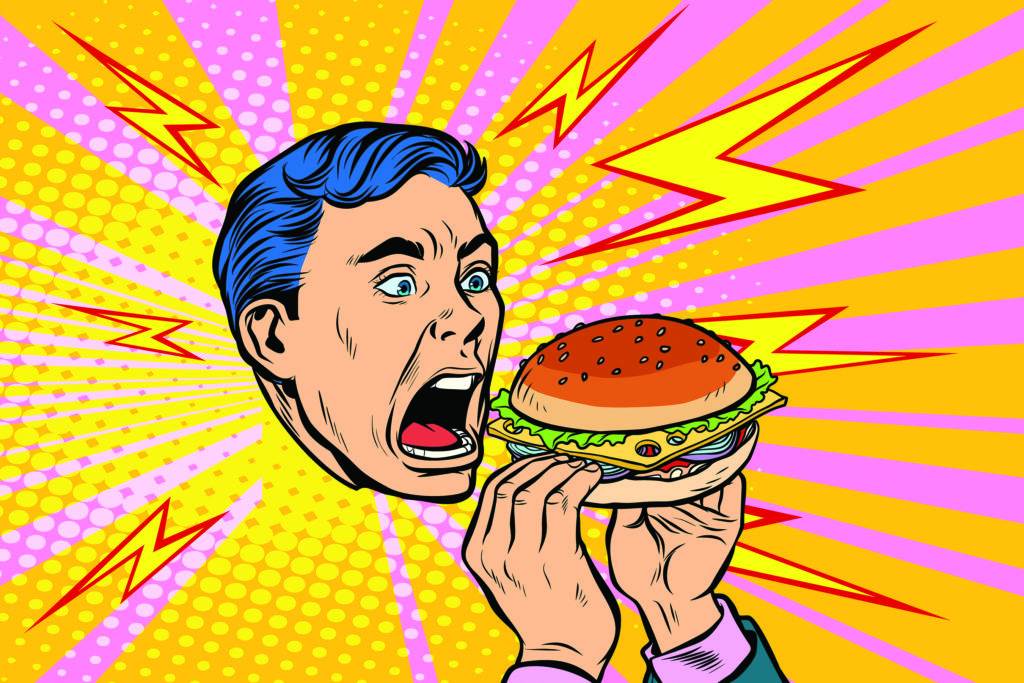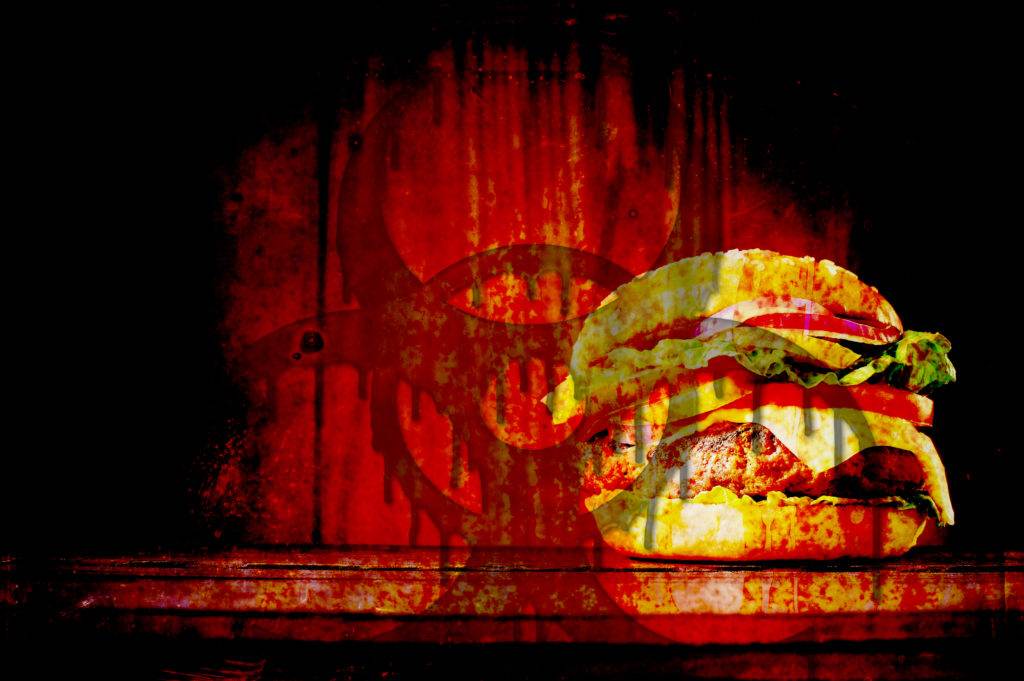Is It Safe?
With much hype, the high-tech food company Impossible Foods is asking health-aware and ecologically conscious consumers to help the environment by eating its plant-based “Impossible Burger.” Though not labeled as such, the burger is a GMO food, and has recently become available in restaurants across the US.
A key ingredient of the Impossible Burger is a protein called soy leghemoglobin (SLH) derived from genetically engineered yeast. SLH contains an add-on component known as “heme.” In its natural form, SLH is found in the root nodules of soybean plants. Impossible Foods has taken the SLH gene from the soybean and used genetic engineering technology to insert it into a strain of yeast. The resulting genetically modified (GM) yeast is grown at an industrial scale in vats, a process known as fermentation. The SLH is then isolated from the yeast and added to the Impossible Burger. The heme component of SLH gives the burger a meat-like taste and makes it “bleed” like rare meat.
The company maintains that SLH is safe to eat but documents obtained under a Freedom of Information request by the ETC Group and other civil society organizations reveal that the FDA initially refused to sign off on the product’s safety. In those 2015 documents the FDA expressed concern that SLH had never been consumed by humans and might be an allergen.
The agency pointed out that the safety information submitted by Impossible Foods was not specific enough: “Although proteins are a part of the human food supply, not all proteins are safe. Information addressing the safe use of modified soy protein does not adequately address safe use of soybean leghemoglobin protein from the roots of the soybean plant in food.” Their conclusion: “FDA believes that the arguments presented, individually and collectively, do not establish the safety of SLH for consumption, nor do they point to a general recognition of safety.”

Impossible Foods countered that SLH is safe to eat because its modeled 3D structure is similar to that of hemoglobin and myoglobin. Generally, hemoglobin and myoglobin are proteins present respectively in the red blood cells and muscles of animals, some of which form part of the human food supply. But the FDA replied, “Conformational similarity or functional similarity among proteins is not an indication of the safety of proteins for consumption.”
Dr. Michael Hansen, senior scientist with Consumers Union, agreed with the FDA, stating, “Just because proteins have similar functions or similar three-dimensional structures doesn’t mean that they’re similar. They can have a very different amino acid sequence, and just slight changes can have impacts.” Such impacts could include unexpected toxicity or allergenicity.
Another safety issue raised by the FDA was that the SLH product extracted from the GM yeast, by Impossible Foods’ own admission, was only 73% pure. The rest was made up of 46 additional yeast proteins, some of which are unidentified. None have been assessed for safety by the company. Impossible Foods says, “The non-target proteins which may co-purify are expected to be safe for consumption based on history of safe consumption of the whole yeast in animals.”
Allergenicity: The problem with Impossible Foods’ statement is that animals are poor predictors of human allergenicity. While it’s unlikely that these yeast proteins are overtly toxic, the yeast does not seem to have been part of the human diet, so we don’t know if it could cause immune reactions and allergies.
Impossible Foods argued against allergenicity, partly on the basis that a bioinformatics analysis using the Allergenonline database did not show a greater than 35% similarity to known allergenic proteins. But the FDA was unconvinced, countering that the approach used in AllergenOnline “does not provide evidence of the lack of sensitization/allergenic potential of SLH.” The agency added, “Analyses using other software, such as SVM modulebased software, indicate that SLH could be an allergen.”
FDA Capitulates: In spite of the FDA’s cautions, and in a sad indictment of the US regulatory system, Impossible Foods was legally able to launch the product onto the market in 2016.
It may be a coincidence that 20 minutes after eating an Impossible Burger for the first time, a man tweeted, “Went into anaphylactic shock & taken to ER. Never happened to me before…” His tweet has since been deleted. Anaphylactic shock is a severe, potentially life-threatening allergic reaction that can occur within seconds or minutes of exposure to something you’re allergic to. This man’s report is not proof that ingredients in the Impossible Burger were to blame for his anaphylactic shock, But given the FDA’s warning, and the timing of the onset of the man’s symptoms, there is reason for caution.
Dr. Michelle Perro, pediatrician and executive director of the website GMOScience, commented, “Food allergies are so commonplace in the American landscape that California schools are now required to have Epipens to treat life-threatening allergic emergencies. The epidemic of food allergies in our population affects approximately 40% of American childr—a number that is likely underreported.”
Dr. Arpad Pusztai, one of the first researchers of GM food safety, raised the issue that newly modified proteins are foreign to our immune systems, which could make them immunogenic and ultimately allergenic. For example, a normally non-allergenic protein in beans (alpha-amylase) was found to cause immunogenic and allergic-type reactions in mice once it had been genetically engineered into peas. “Given these facts, to introduce another potential allergen into the food supply before it has been properly tested appears highly irresponsible.”
AllergenOnline: Links to Monsanto
The AllergenOnline database (AllergenOnline. org) is “a tool for evaluating the safety of proteins included in foods through processing or genetic modification.” The database, funded by biotechnology companies, is managed by Richard E. Goodman, a former Monsanto scientist. Impossible Foods contracted Goodman to assess SLH’s potential allergenicity as part of its submission to the FDA. According to the submission, “Dr. Goodman’s expert opinion concluded that soybean leghemoglobin is very unlikely to present a risk of dietary allergy to consumers.” Goodman also published his opinion in a peer-reviewed article co-authored by an Impossible Foods scientist.
To the FDA’s credit, it was not initially swayed by Goodman’s “expert opinion” and refused to give Impossible Burger its safety stamp. In 2015 Impossible Foods withdrew its FDA request that SLH receive GRAS (Generally Recognized as Safe) status but tried again in 2017 by submitting data from a study that it had commissioned in which rats were fed SLH.

Seemingly the study was intentionally designed to minimize the chances of finding any adverse effects. Predictably SLH did not produce acute toxicity to the point that rats keeled over and died. (The adverse effects from a novel food substance would likely be subtle.) An effective test to better extrapolate human safety would require long-term studies with relatively large numbers of animals. Impossible Foods testing was statistically underpowered with too few animals, only 10 per sex per group. More importantly the study was too short in duration, just 28 days, the equivalent to two to three years in a human.
Yet, given these limitations it is remarkable that the SLH-fed rats did show a large number of adverse and potentially adverse effects, for example:
» unexplained body weight gain
» increase in food consumption without weight gain
» changes in blood chemistry
» decreased reticulocyte (immature red blood cell) count (this can be a sign of anemia)
» decreased blood clotting ability
» decreased blood levels of alkaline phosphatase (can indicate malnutrition and/or celiac disease)
» increased blood albumin (can indicate acute infection or damage to tissues) and potassium values (can indicate kidney disease)
» decreased blood glucose (low blood sugar) and chloride (can indicate kidney problems)
» increased blood globulin values (common in inflammatory disease and cancer).
Most alarmingly, the study revealed apparent disruptions in the reproductive cycle among some groups of females fed SLH. In normal healthy rats, the uterus fills up with fluid during the proestrus phase of the cycle, when the ovarian follicles are maturing in the run-up to the fertile and sexually receptive estrus phase. In the SLH-fed rats, significantly fewer “fluid filled” uteri were seen. This correlated with decreased uterus weight, as might be expected.
In response to this finding, Impossible Foods commissioned a second rat feeding study, which found no effect from the SLH on the rats’ estrus cycle. The company concluded that the findings of the first study had been a mere artifact of the experimental method used. Smell a rat? Let’s hope, for the sake of the women who eat the Impossible Burger on a regular basis, that the company is correct! Suffice it to say that the very fact that there were such a large number of statistically significant changes in multiple organs and systems in the lab-tested rats suggests that closer scrutiny of the safety of SLH is urgently required.
The only way of ascertaining if potentially adverse effects seen in short studies are truly adverse or have lasting consequences is to extend the study length to the rats’ full lifetimes (two to three years) and to do multigenerational testing. In the Impossible Burger case, neither was done.
FDA capitulates again: Impossible Foods’ second attempt to obtain GRAS status for SLH succeeded and the FDA issued a “no questions” letter, indicating that it had no further questions. Contrary to what many people believe, such letters are not an assertion by the FDA that the food in question is safe. They state that the company asserts that the food is safe and remind the company that it is responsible for ensuring that it puts only safe foods on the market. “No questions” letters may protect the FDA from liability in case something goes wrong. But they do not protect the consumer from unsafe novel foods.
What the public wants: The claims made for the Impossible Burger’s health credentials are at best questionable and at worst highly misleading. And in all likelihood for Common Ground readers, the picture of a burger consisting of a novel, potentially unsafe protein produced from GM yeast, mixed together with highly processed plant protein extracts and a host of chemically synthesized ingredients brewed up in fermentation vats is unlikely to sit well. But the more fundamental point is that this burger, the product of poorly tested novel and synthetic ingredients and GMOs, represents the opposite of what an increasingly food-aware and environmentally conscious public wants—pure, minimally processed natural ingredients, free from GMOs, transparently sourced, and produced with as few chemical and synthetic inputs as possible.
Claire Robinson is editor at GMWatch, a public news and information service covering GM foods and their associated pesticides. GMWatch.org. Michael Antoniou, PhD, is a research group leader and professor of molecular genetics at a leading London university.